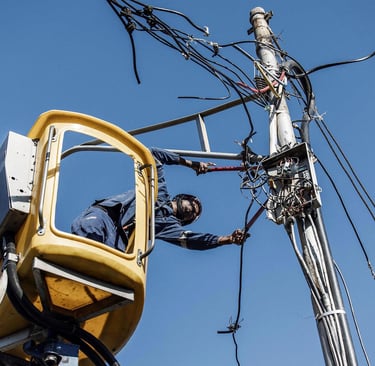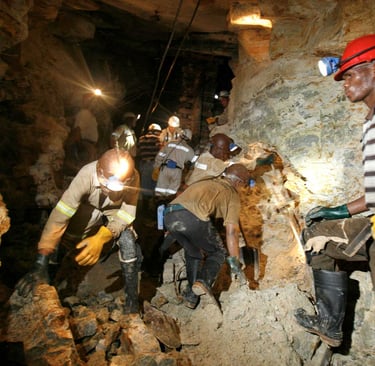Anhui Feichun Special Cable Co.,Ltd Li.wang@feichuncables.com
What Are Quick Fixes for Power Interruptions Caused by Mining Cable Faults?
Learn about quick fixes for power interruptions due to mining cable faults. Understand common types of faults, solutions, safety considerations, and best practices in South African mining operations.
Li.wang@Feichun Cable
7/15/20255 min read


Power interruptions caused by cable faults are a significant concern in the mining industry, particularly in South Africa, where mining operations are vital to the national economy. When power is lost, it can lead to costly downtime, delays, and potential hazards. In a sector that demands high operational efficiency and safety, minimizing these interruptions is crucial.
Mining cables, which provide power to various equipment, are subject to damage from mechanical stress, electrical faults, and environmental wear. As mining operations are often located in harsh environments, these cables can face various risks that impact their reliability. For this reason, understanding quick fixes for mining cable faults is critical for ensuring minimal disruptions to the workflow.
This article will explore the types of mining cable faults, how to identify them, and the quick fix solutions that can be applied in emergency situations. By addressing these issues promptly, mining companies can improve safety and prevent significant financial losses.
Types of Mining Cable Faults
Mining cables face numerous threats that can result in power outages. Understanding these faults is the first step in developing efficient solutions.
Mechanical Damage
Mechanical damage is one of the most common causes of cable failure. Cables can be crushed, cut, or bent by heavy machinery, sharp edges, or accidental impact. In underground mines, equipment such as drills, excavators, and conveyor systems can cause this damage. The cables may also be affected by environmental factors like excessive vibrations or ground movement.
Electrical Faults
Electrical faults can occur when there is a short circuit, ground fault, or overload in the cable's electrical system. Short circuits can lead to power loss, equipment damage, or even fires in extreme cases. These faults often occur when cables are exposed to water, chemicals, or other corrosive materials that degrade the insulation.
Insulation Failures
Insulation is essential for the safe and reliable operation of mining cables. Over time, the insulation can deteriorate due to wear, heat, or environmental exposure. Once the insulation is damaged, it may lead to power leakage, short circuits, or even electrocution risks. Regular inspections and proper maintenance can help detect insulation failures early.
Corrosion and Environmental Factors
The harsh conditions in mining environments, including exposure to moisture, chemicals, dust, and extreme temperatures, can cause corrosion of the cables' outer layers. This weakening of the cable's protective sheath can expose the electrical conductors and lead to power disruptions. Corrosion is particularly common in underground mines where humidity and dust are prevalent.
FAQ:
What are the most common types of cable faults in mining operations?
Mechanical damage, electrical faults, insulation failures, and corrosion are the most common cable faults in mining operations.
How can these faults be identified early?
Routine inspections, use of cable fault detectors, and monitoring systems can help identify these faults before they cause significant issues.
Quick Fix Solutions for Mining Cable Faults
Once a fault is identified, quick fixes are necessary to restore power and minimize operational downtime. Below are some of the most effective solutions:
Identifying the Fault Location
Identifying the exact location of a cable fault is essential for implementing a quick fix. The following tools and methods can be employed:
Cable Fault Locators: Devices such as Time Domain Reflectometers (TDR) and cable fault testers can pinpoint the location of a fault with high accuracy.
Visual Inspection: Inspecting cables for visible signs of damage, such as frayed insulation, cuts, or corrosion, can help identify problems. Infrared cameras are useful for detecting overheating cables and short circuits.
Temporary Repairs
Once the fault is located, a series of temporary repairs can be made to restore power until permanent fixes can be implemented:
Mechanical Repair: For mechanical damage, using cable joints, connectors, and clamps can temporarily restore the cable’s integrity.
Electrical Repair: Electrical faults can be addressed by using insulation tape, heat shrink tubing, or silicone sealants to cover exposed areas and prevent short circuits.
Corrosion Protection: Applying corrosion-resistant coatings or sealants to exposed cables can prevent further degradation.
Emergency Power Bypass
In cases where the fault is significant, an emergency power bypass may be necessary to maintain operations. Temporary cables or generators can be used to bypass the damaged section of the mining cable, ensuring that power supply is not interrupted while repairs are being carried out.
Case Study: South African Gold Mine's Temporary Power Bypass
A recent case at a South African gold mine involved an underground cable fault caused by mechanical damage from heavy machinery. The mine quickly deployed a temporary power bypass using flexible cables to restore power to critical operations. This quick response prevented a significant loss of production and ensured safety until permanent repairs could be made.
Voltage and Current Testing
After performing the repairs, it’s crucial to test the voltage and current to ensure that the cable is stable before it is returned to full operation. This ensures that the temporary fix will not cause additional faults or safety issues.
FAQ:
What tools are essential for performing quick fixes on mining cables?
Essential tools include cable fault locators, insulation tape, heat shrink tubing, cable joints, and clamps.
What safety measures should be followed when performing these repairs?
Always de-energize the cable before starting repairs, use proper personal protective equipment (PPE), and ensure that the work area is secure.
Safety Considerations
Repairing mining cables involves high risks, particularly when working with high-voltage electrical systems. Following safety protocols is paramount to prevent injuries.
De-Energizing the Cable: Before beginning repairs, it is essential to de-energize the affected cable and ensure the work area is secured. This includes using lockout/tagout procedures.
Personal Protective Equipment (PPE): Workers should be equipped with the appropriate PPE, including insulated gloves, rubber boots, and eye protection, to safeguard against electrical hazards.
Training and Knowledge: It is crucial that all workers are trained to recognize electrical faults and perform quick repairs safely. Regular training programs can ensure that workers are up-to-date on the latest safety standards and techniques.
FAQ:
What PPE should be used during cable repairs?
Insulated gloves, rubber boots, and eye protection are essential.Are there any industry regulations governing emergency repairs on mining cables?
Yes, regulations such as the Mine Health and Safety Act (MHSA) guide safety protocols during electrical repairs.
Preventative Measures to Reduce Future Faults
While quick fixes are necessary in the short term, long-term prevention strategies are crucial to minimize the occurrence of mining cable faults.
Cable Selection
Selecting the right cable with robust insulation, high resistance to abrasion, and corrosion-resistant coatings can significantly reduce the likelihood of faults. Cables designed specifically for mining operations should meet industry standards such as SANS 1520.
Regular Maintenance
Scheduled inspections and testing of mining cables help identify wear and tear before they result in failure. Monitoring the performance of cables through thermal imaging and voltage testing is an effective way to spot potential issues early.
Environmental Controls
Mining companies should implement measures to shield cables from extreme weather conditions, chemicals, and mechanical stress. Installing cable trays or using protective sheaths can prevent environmental damage.
Training Workers
Providing ongoing education on how to identify early signs of cable faults is vital. Workers should be taught to recognize common warning signs, such as unusual heat patterns or wear on cables, and take immediate corrective action.
Case Study:
A platinum mine in South Africa implemented a proactive maintenance program that included regular cable inspections and the use of advanced monitoring systems. As a result, they reduced power interruptions by 40% and significantly lowered repair costs.
FAQ:
How can mining companies prevent cable faults in the long term?
By selecting high-quality cables, conducting regular inspections, and training workers on preventive measures.What role does regular maintenance play in ensuring power reliability in mines?
Regular maintenance helps identify potential issues early, preventing costly and disruptive cable failures.
Conclusion
In the demanding environment of South African mines, power interruptions due to cable faults are a significant challenge. However, quick and effective fixes can minimize downtime and ensure continued productivity. Identifying faults early, performing temporary repairs, and following safety protocols are crucial steps in maintaining a reliable power supply.
In addition, adopting preventive measures such as selecting high-quality cables, conducting regular inspections, and training workers can significantly reduce the occurrence of faults in the future. By investing in these strategies, mining companies can ensure the safety and efficiency of their operations.
FAQ
What are the common causes of mining cable faults?
Mechanical damage, electrical faults, insulation failures, and environmental factors are the leading causes of cable faults in mining operations.How can I prevent mining cable faults in the future?
By using robust cables, conducting regular maintenance, and training staff to spot early signs of faults.What tools are required for fixing mining cables quickly?
Cable fault locators, mechanical connectors, insulation materials, and voltage testing equipment are essential for quick fixes.



Email Address: Li.wang@feichuncables.com
© 2025. All rights reserved.


One-click to Quickly Contact
Products
Offshore & Marine Cable
XLPE Cable
Contact
Company
Location:
Building A Private Science and Technology Park, Hefei Economic and Technological Development Zone, Anhui Province, China
